
HMS Invincible was the Royal Navy's lead ship of her class of three light aircraft carriers. She was launched on 3 May 1977 as the seventh ship to carry the name. She was originally designated as an anti-submarine warfare carrier, but was used as an aircraft carrier during the Falklands War, when she was deployed with HMS Hermes. She took over as flagship of the British fleet when Hermes was sold to India. Invincible was also deployed in the Yugoslav Wars and the Second Gulf War. In 2005, she was decommissioned, and was eventually sold for scrap in February 2011.

HMS Albion is an amphibious transport dock of the Royal Navy, the first of the two-ship Albion class. Built by BAE Systems Marine in Barrow-in-Furness, Albion was launched in March 2001 by the Princess Royal. Her sister ship, Bulwark, was launched in November 2001, also from Barrow. Affiliated to the city of Chester and based in Plymouth, she is the ninth ship to carry the name Albion, stretching back to the 74-gun 1763 warship, and last carried by an aircraft carrier decommissioned in 1973 after 19 years service. Designed as an amphibious warfare ship, Albion carries troops, normally Royal Marines, and vehicles up to the size of the Challenger 2 main battle tank. She can deploy these forces using four Landing Craft Utility (LCUs) and four Landing Craft Vehicle and Personnel (LCVPs). A flight deck supports helicopter operations.

HMS Cromer is a Sandown-class minehunter commissioned by the Royal Navy in 1992. She was named after the North Norfolk seaside town of the same name.
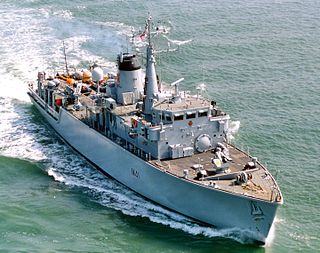
The Hunt class is a class of thirteen mine countermeasure vessels of the Royal Navy. As built, they combined the separate roles of the traditional minesweeper and that of the active minehunter in one hull, but later modifications saw the removal of mine-sweeping equipment. They have a secondary role as offshore patrol vessels.
Two ships of the Royal Navy have been named HMS Walney after Walney Island off the coast of Barrow-in-Furness, Cumbria:

The Sandown class is a class of fifteen minehunters built primarily for the Royal Navy by Vosper Thornycroft. The Sandown class also serve with the Royal Saudi Navy and the Estonian Navy. The first vessel was commissioned into Royal Navy service on 9 June 1989 and all the British ships are named after coastal towns and cities. They have a secondary role as offshore patrol vessels.

HMS Repulse (S23) was a Resolution-class ballistic missile submarine of the Royal Navy.

The Huon-class minehunter coastal (MHC) ships are a group of minehunters built for the Royal Australian Navy (RAN). Following problems with the Bay-class minehunters, a request for tender was issued in 1993 for a class of six coastal minehunters under the project designation SEA 1555. The tender was awarded in 1994 to the partnership of Australian Defence Industries (ADI) and Intermarine SpA, which was offering a variant of the Italian Gaeta-class minehunter.

HMS Brecon was a Hunt-class mine countermeasures vessel that served with the Royal Navy. Her pennant number was M29.
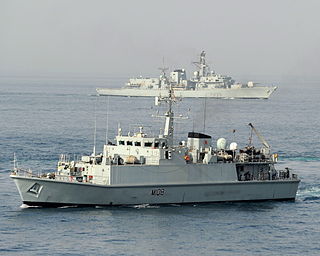
HMSGrimsby is a Sandown-class minehunter of the British Royal Navy, and the second ship to bear the name.

HMS Pembroke is a Sandown-class minehunter of the Royal Navy. She was the second ship launched of the second batch of the class, which had several improvements over the first five ships built. The ship was posted for three years to the Persian Gulf between 2009 and 2012. Pembroke has since been deployed in international exercises and in historic ordnance detection in home waters. Pembroke was the first of the Royal Navy’s Mine Countermeasures Vessels to be fitted with the Oceanographic Reconnaissance Combat Architecture combat system to replace the previous NAUTIS combat system in early 2020.
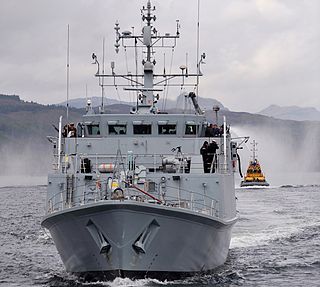
HMS Ramsey is a Sandown-class minehunter of the British Royal Navy. Like other vessels of the Sandown class, Ramsey was built of glass-reinforced plastic and other non-magnetic materials so that her hull does not trigger naval mines as easily as standard warships.

HMS Blyth is a Sandown-class minehunter of the British Royal Navy. She is the second vessel to bear the name. The first being a Bangor-class minesweeper of the Second World War, pennant number J15.

HMS Shoreham is a Sandown-class minehunter of the British Royal Navy. She is the fifth vessel to bear the name. From 2018 to 2021, Shoreham was deployed at HMS Jufair together with three other mine countermeasures ships as part of 9 Mine Countermeasures Squadron on Operation Kipion.

HMSInverness(M102) was a Sandown-class minehunter of the Royal Navy. She was decommissioned by the Royal Navy in 2005, and in 2008 became EMLSakala(M314) of the Estonian Navy.
HMS Berkeley was a Hunt-class mine countermeasures vessel of the British Royal Navy. She was sold to the Hellenic Navy in 2001 and was commissioned as HS Kallisto. On 27 October 2020, she was cut in two in a collision with a container ship.
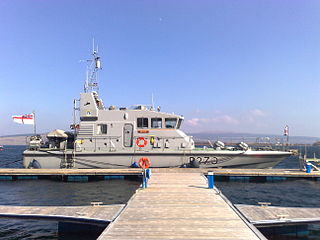
HMS Biter is an Archer-class P2000-type patrol and training vessel of the British Royal Navy. She is assigned to Manchester & Salford Universities Royal Naval Unit, a Royal Naval Reserve unit based in Manchester. The ship is based at HMS Eaglet, the Royal Naval Headquarters in Liverpool. As part of her sea training programme, she often makes visits to local ports for ceremonial visits or occasions.

EML Admiral Cowan (M313) is a Sandown-class minehunter. Formerly HMS Sandown, lead ship of her class of the Royal Navy, she is now an Estonian Navy ship. Renamed EML Admiral Cowan, she is the flagship of the Estonian Navy and part of the Estonian Navy's mine sweeping flotilla. Admiral Cowan is the lead vessel of the Estonian Navy Mineships Division and also the first of the three modernised Sandown class minehunters received.
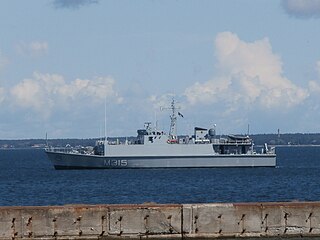
EML Ugandi is a Sandown-class minehunter commissioned by the Estonian Navy in 2009. Ugandi is a former British Royal Navy vessel HMS Bridport built by Woolston Yard of Southampton-based shipbuilders Vosper Thornycroft.

The Port of Barrow refers to the enclosed dock system within the town of Barrow-in-Furness, England. Morecambe Bay is to the east of the port and the Irish Sea surrounds it to the south and west. The port is currently owned and operated by Associated British Ports Holdings, but some land is shared with BAE Systems Submarine Solutions. Currently consisting of four large docks, the Port of Barrow is one of North West England's most important ports. The docks are as follows: Buccleuch Dock, Cavendish Dock, Devonshire Dock and Ramsden Dock. The port of Barrow is the only deep water port between the Mersey and the Clyde.


















